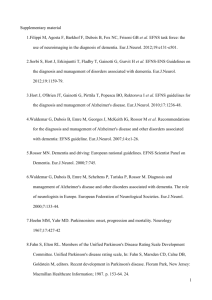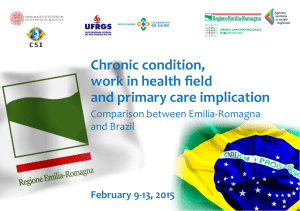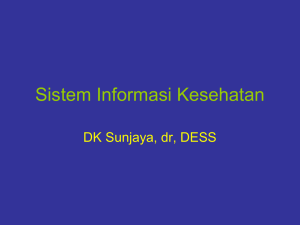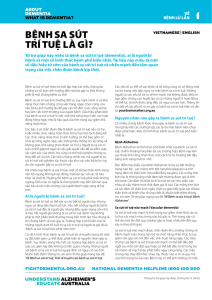Dementia and chronic diseases a global view (Martin Prince)
advertisement
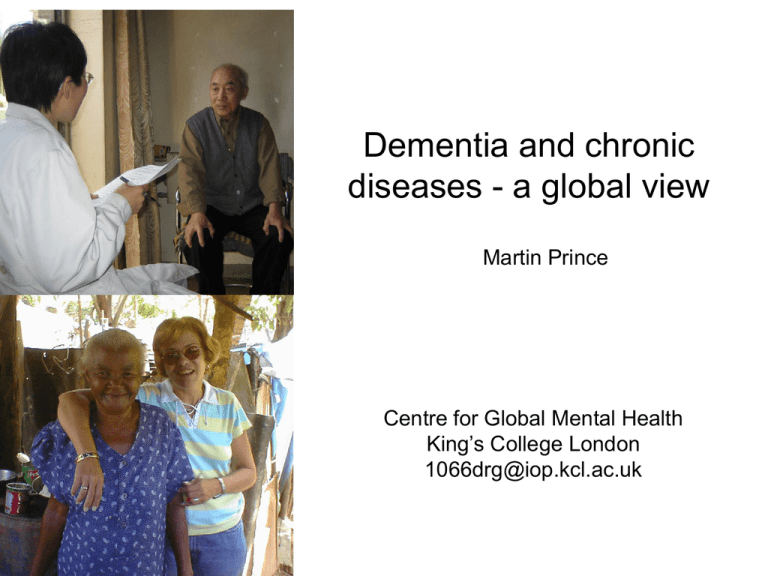
Dementia and chronic diseases - a global view Martin Prince Centre for Global Mental Health King’s College London 1066drg@iop.kcl.ac.uk Global population ageing – where do older people live? The world’s population is ageing. People are living longer, and fertility is declining This process is occurring more rapidly in developing countries In 1950, just over half of the world’s older population lived in less developed regions By 2050, the proportion will be 80% Discourses around global ageing “Ageing is a development issue. Healthy older persons are a resource for their families, their communities and the economy” (WHO Brasilia Declaration on Ageing, 1996) “Global aging is the dominant threat to global economic stability - without sweeping changes to age-related public spending, sovereign debt will soon become unsustainable” (Standard and Poor’s – Global Aging 2010: an irreversible truth) Some important questions What is different about old age? Degenerative disorders – stroke, dementia Not one condition but several (comorbidity) Disability, and needs for long-term care Fragile economic and social protection Why do older people matter? Account for the majority of disease burden and cost (health and societal) Underserved Major Challenges? Access to effective, age-appropriate healthcare Attention to dependence and long-term care What are the chronic diseases, and why do they matter? Heart disease, stroke, cancer, diabetes, mental disorder, dementia, blindness, deafness Tend to impact later in life, although some evidence for increased mortality at younger ages in low and middle income countries Incurable conditions, requiring long-term management ‘Lifestyle’ risk factors – smoking, underactivity, diet, obesity Associated with considerable mortality and disability Already the leading cause of death in all world regions apart from sub-Saharan Africa A global epidemic Population ageing The ‘health transition’ – globalisation of risk behaviours Leading contributors to global burden of disease among people aged 60+ 160 140 120 100 LIC 80 MIC 60 HIC 40 20 Ca rd io va sc ul a Ca r nc Se er Ch ns r Ne on ory ic ur re op sy sp ch . ia t In ric fe ct Re ion sp . Di inf. ge st Di ive ab et es M us cu Inju lo r sk y el et al 0 Millions of Disability Adjusted Life Years (DALYs) by cause and region What is dementia? A syndrome, not a single disorder Characterised by progressive cognitive impairment (memory, language, thinking, judgment) Many underlying causes – Alzheimer’s disease, vascular dementia, Dementia with Lewy bodies, Frontal Temporal dementia A condition of later life Around 5% of cases have onset before the age of 60 Prevalence doubles with every five year increase in age Low levels of awareness and help-seeking A ‘normal part of ageing’ ‘Nothing can be done’ Stigma and shame A large ‘treatment gap’ Half to two-thirds not diagnosed in high income countries 90% + not diagnosed in low and middle income countries Developed/ developing country differences? 35 % prevalence 30 EURODEM Ibadan, Nigeria Ballabgarh, India 25 20 15 10 5 0 Age 60- 70- 80- 90 R ic o ub a C DR ar Pe ac ru as Pe (urb M ru ) ex (r ic ur M o( ) ex ur ic b) C o( hi ru na r) ( C hi urb na ) In (ru di a r) In (ur di b) a (r S ur) Af ric a C to Pu er Prevalence of 10/66 and DSM IV Dementia 20 15 % 10 DSMIV 5 1066 0 DSMIV So is it 8-10% or <1%? Rodriguez et al for 10/66, Lancet 2008 A global epidemic 36 million now 66 million by 2030 115 million by 2050 One new case every 4 seconds The impact of dementia • Mainly through years disability, not mortality lived with • Among older people, dementia contributes much more than other chronic diseases to – Disability (Sousa et al, Lancet, 2009) – Needs for care (Sousa et al, BMC Geriatrics, 2010) – Carer strain (Honyashiki M, Int Psychogeriatrics 2011) • Economic cost…….. The chronic disease global health agenda IN • Focus on prevention of ‘premature’ mortality • Prioritisation of CVD, cancer, diabetes • Anti-smoking measures, salt reduction, diet, activity OUT • Ageing? • Consequences of failed prevention? • Management of chronic conditions in late-life? • Disability and long-term care? Why might this be short-sighted – Economic cost of dementia (Dementia UK report) Economic cost of dementia 683,000 people with dementia 1.7 million by 2050 8% 15% Total costs £17 billion 41% Costs per person Average £25,472 36% Mild dementia (community) Moderate dementia (Community) £14,540 £20,355 People in care homes £31,263 Health service Community care Informal care Care homes • World Alzheimer Day, September 21st, London, 2010 – Global Societal Economic cost – $604bn – 1% of GDP – Equivalent to world’s 18th largest economy – Larger than the annual turnover of Walmart Anders Wimo Karolinska Institute, Sweden Martin Prince King’s College London, UK Long term care, and social protection for older people Social protection legislation in India “Old age has become a major social challenge and there is need to give more attention to care and protection of older persons. Many older persons . . . are now forced to spend their twilight years all alone and are exposed to emotional neglect and lack of physical and financial support”. Government of India (2007), “With the joint family system withering away, the elderly are being abandoned. This has been done deliberately as they (the children) have a lot of resources which the old people do not have.” Social Justice Minister, Meira Kumar Social protection for people with dementia in India (10/66 DRG) Urban Chennai Rural Vellore Pension 13.3% 26.9% Money from family Disability pension Food insecurity 28.0% 44.4% 2.7% 0.0% 28.0% 17.6% No children available locally 9.3% 7.5% More carrot, less stick…. 1. Universal non-means tested ‘social’ pensions 2. Access to disability benefits for people with dementia 3. Caregiver benefits 4. Promote independence, prevent and manage dependence 5. Provide basic information, training and support for caregivers in the community Long-term care policy WHO report (2002) • each community should determine – the types and levels of assistance needed by older people and their carers – the eligibility for and financing of long-term care support. • In practice, governments – Do not provide or finance long-term care – Lack comprehensive policies and plans Intervention - the problem • Dementia is a hidden problem (demand) • Little awareness • Not medicalised • People do not seek help • Health services do not meet the needs of older people (supply) • No domiciliary assessment/ care • Clinic based service • No continuing care • ‘Out of pocket’ expenses Prince et al, World Psychiatry, 2007 WHO • The Increasing theMental coverage of evidence-based community interventions in low and middle income countries Health Global Action Plan • Seven priority areas – depression, psychosis, epilepsy, dementia, child and adolescent disorders, alcohol use, suicide • Development of evidence-based practice guidelines for non-specialists in LAMIC • Implementation • Evaluation Packages of care for dementia – not rocket science! • Casefinding • Brief diagnostic screening assessment • Making the diagnosis well – information and support • Attention to physical health • Carer interventions • Commitment to continuing care Prince et al, PLOS Medicine 2010 A more integrated approach? VERTICAL (HEALTH CONDITIONS) • Dementia • Stroke • Parkinson’s disease • Depression • Arthritis and other limb conditions • Anaemia HORIZONTAL (IMPAIRMENTS) • Communication • Disorientation • Behaviour disturbance • Sleep disturbance • Immobility • Incontinence • Nutrition/ Hydration • Caregiver knowledge • Caregiver strain Conclusions • The world is facing a new epidemic of unprecedented proportions • Its effects will be felt particularly in low and middle income countries - currently least prepared to meet the challenge • Societal costs will rise inexorably, driven by the increasing need for long term care • Time for action – Clinical care – Social policy – Prevention
